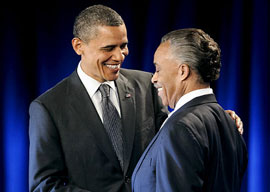
July 23, 2013

President Barack Obama and Rev. Al Sharpton
“That happens often,” said Obama. Undeniably. But why do black males awaken such apprehensions and fears? Is it their color?
Well, 13 percent of our population is black. Half of that—say, 6 plus percent—is male. Of that 6 percent, one in six—just 1 percent of the U.S. population—consists of black males age 18 to 29.
Of all black males 18 to 29, writes Ron Unz in “Race and Crime in America,” 28 percent are in jail or prison, or on probation.
The “liberal Sentencing Project organization,” says Unz, estimates that “one-third of all black men are already convicted criminals by their 20s, and the fraction would surely be far higher for those living in urban areas.”
Twenty years ago in Chicago, where black kids are gunned down daily, Jesse Jackson was quoted, “There is nothing more painful to me at this stage in my life than to walk down the street and hear footsteps and start thinking about robbery. Then look around and see somebody white and feel relieved.”
That’s the same apprehension, Mr. President, those women feel on that elevator.
Obama traced the “violence … in poor black neighborhoods” to “poverty and … a very difficult history.
But slavery and segregation were far closer in time to the black America of the 1950s, and poverty was far greater. Yet we never saw crime and incarceration rates like we see today in Black America.
As Unz writes, El Paso, Texas, and Atlanta are cities of equal size and poverty rates. Yet Atlanta has 10 times the crime. Oakland and Santa Ana, Calif., are equal in size and poverty numbers. Yet Oakland “has several times the rate of crime.” Why?
Why are white folks nervous about strange young black men in the neighborhood? Perhaps because they commit interracial muggings, robberies and rapes at 35 times the rate of whites.
As newspapers avoid the issue of black racism and rarely give the stats on interracial crime, Obama dwelt lovingly on the indignities of racial profiling—without really addressing the root cause.
It was an uncourageous commentary. Weak as Kool-Aid, said Tavis.
But Obama was where he likes to be, leading from behind—this time behind Al Sharpton.